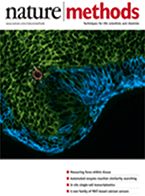-
REAGENT SERVICES
Hot!
-
Most Popular Services
-
Molecular Biology
-
Recombinant Antibody/Protein
-
Reagent Antibody
-
CRISPR Gene Editing
-
DNA Mutant Library
-
IVT RNA and LNP Formulations
-
Oligo Synthesis
-
Peptides
-
Cell Engineering
-
- Gene Synthesis FLASH Gene
- GenBrick™ Up to 200kb
- Gene Fragments Up to 3kb now
- Plasmid DNA Preparation Upgraded
- Cloning and Subcloning
- ORF cDNA Clones
- mRNA Plasmid Solutions New!
- Cell free mRNA Template New!
- AAV Plasmid Solutions New!
- Mutagenesis
- GenCircle™ Double-Stranded DNA New!
- GenSmart™ Online Tools
-
-
PRODUCTS
-
Most Popular Reagents
-
 Instruments
Instruments
-
Antibodies
-
ELISA Kits
-
Protein Electrophoresis and Blotting
-
Protein and Antibody Purification
-
Recombinant Proteins
-
Molecular Biology
-
Stable Cell Lines
-
Cell Isolation and Activation
-
 IVD Raw Materials
IVD Raw Materials
-
 Therapy Applications
Therapy Applications
-
Resources
-
- All Instruments
- Automated Protein and Antibody Purification SystemNew!
- Automated Plasmid MaxiprepHot!
- Automated Plasmid/Protein/Antibody Mini-scale Purification
- eBlot™ Protein Transfer System
- eStain™ Protein Staining System
- eZwest™ Lite Automated Western Blotting Device
- CytoSinct™ 1000 Cell Isolation Instrument
-
- Pharmacokinetics and Immunogenicity ELISA Kits
- Viral Titration QC ELISA Kits
- -- Lentivirus Titer p24 ELISA KitHot!
- -- MuLV Titer p30 ELISA KitNew!
- -- AAV2 and AAVX Titer Capsid ELISA Kits
- Residual Detection ELISA Kits
- -- T7 RNA Polymerase ELISA KitNew!
- -- BSA ELISA Kit, 2G
- -- Cas9 ELISA KitHot!
- -- Protein A ELISA KitHot!
- -- His tagged protein detection & purification
- dsRNA ELISA Kit
- Endonuclease ELISA Kit
- COVID-19 Detection cPass™ Technology Kits
-
- Automated Maxi-Plasmid PurificationHot!
- Automated Mini-Plasmid PurificationNew!
- PCR Reagents
- S.marcescens Nuclease Benz-Neburase™
- DNA Assembly GenBuilder™
- Cas9 / Cas12a / Cas13a Nucleases
- Base and Prime Editing Nucleases
- GMP Cas9 Nucleases
- CRISPR sgRNA Synthesis
- HDR Knock-in Template
- CRISPR Gene Editing Kits and Antibodies
-
![AmMag™ Quatro Automated Plasmid Purification]() AmMag™ Quatro automated plasmid purification
AmMag™ Quatro automated plasmid purification
-
![Anti-Camelid VHH]() MonoRab™ Anti-VHH Antibodies
MonoRab™ Anti-VHH Antibodies
-
![ELISA Kits]() ELISA Kits
ELISA Kits
-
![Precast Gels]() SurePAGE™ Precast Gels
SurePAGE™ Precast Gels
-
![Quatro ProAb Automated Protein and Antibody Purification System]() AmMag™ Quatro ProAb Automated Protein and Antibody Purification System
AmMag™ Quatro ProAb Automated Protein and Antibody Purification System
-
![Target Proteins]() Target Proteins
Target Proteins
-
![AmMag™ Quatro Automated Plasmid Purification]() AmMag™ Quatro automated plasmid purification
AmMag™ Quatro automated plasmid purification
-
![Stable Cell Lines]() Stable Cell Lines
Stable Cell Lines
-
![Cell Isolation and Activation]() Cell Isolation and Activation
Cell Isolation and Activation
-
 IVD Raw Materials
IVD Raw Materials
-
![Quick
Order]() Quick Order
Quick Order
-
![Quick
Order]() Quick Order
Quick Order
- APPLICATIONS
- RESOURCES
- ABOUT US
- SIGN IN My Account SIGN OUT
- REGISTER

![Alternative splicing boosts brain size Alternative splicing boosts brain size]()
Neuroscience Research Applications for Gene Synthesis
Resources » Technical Resource Centers » Gene Technical Resources » Applications for Gene Synthesis » Neuroscience Research
Overview
Gene synthesis is widely used in neuroscience research studies: codon-optimized channelrhodopsins enable optogenetic approaches to visualizing neuronal pathways; customized ORF clones and RNAi constructs elucidate glioblastoma signaling pathways; and gene variants are used to investigate neuronal signalling mechanisms that underlie synapse plasticity and learning behaviors, just to name a few. GenScript is the most cited gene synthesis provider in the world, with over 300 neuroscience publications citing our gene synthesis services and other bio-reagent services and products. Read more to see why neurobiologists around the world use gene synthesis to help accelerate their research.
Explore recent publications that used gene synthesis, or read about featured research news topics below.
- Chuong et al. Noninvasive optical inhibition with a red-shifted microbial rhodopsin. Nat Neurosci. 2014 Aug;17(8):1123-9. Read full text
- Zimmermann et al. Synaptobrevin 1 mediates vesicle priming and evoked release in a subpopulation of hippocampal neurons. J Neurophysiol. 2014 Jun 18. Read full text
- Watt et al. Do current therapeutic anti-Aβ antibodies for Alzheimer's disease engage the target? Acta Neuropathol. 2014 Jun; 127 (6); 803-10. Read full text
- Hansen et al. Distinct functional and pharmacological properties of Triheteromeric GluN1/GluN2A/GluN2B NMDA receptors. Neuron. 2014 Mar 5;81(5):1084-96. Read full text

Alternative Splicing Boosts Brain Size
mammalian-specific splice variant of PTBP1 drives neurogenesis
Humans have about the same number of genes as simpler vertebrates – so how does our genome give rise to such a stunning diversity of proteins, brain structures, and ultimately to the behaviors that make us human? Alternative splicing plays a big role, as a new paper published in Science shows – and a single exon-skipping event in a critical regulatory protein PTBP1, drives widespread changes in splicing that could account for the huge differences in brain development across vertebrate species.
By expressing a mammalian-specific splice variant of PTBP1 in chickens, scientists gained clues into why mammals develop larger brains than other vertebrates. PTBP1 regulates the splicing of hundreds of downstream target genes, and the mammalian-specific splice variant activates a brain-specific program of alternative splicing, favoring the creation of new neurons. Further studies will investigate how the different forms of PTBP1 hand off control during specific stages of embryonic development to regulate neurogenesis and brain size.
GenScript offers molecular biology services to accelerate research on alternative splicing and the molecular mechanisms governing neurogenesis and brain tissue patterning:
- Gene synthesis, with industry-leading codon optimization, starting at $0.23/bp
- Express Cloning: 151 free vectors to choose from to get expression-ready clones for just $49/clone
- CRISPRgRNA constructs: validated gRNA sequences in your choice of vector for $199/clone
Gueroussov et al. An alternative splicing event amplifies evolutionary differences between vertebrates. Science. 2015 Aug 21;349(6250):868-73. Read the Full Text

Optogenetics Goes Two-Channel
New opsins Chronos and Chrimson solve the problem of how to excite distinct neuronal populations.
 "Optogenetics" allow researchers to stimulate synaptic
activity in specific neurons that are made to express light-sensitive ion channels (channelrhodopsins).
Despite the variety of opsins with different peak wavelength sensitivities, until now it has not been possible
to independently activate two distinct neural populations without significant cross-talk or losing temporal
resolution. Researchers at MIT reported in Nature on two new opsins with non-overlapping excitation
spectra, Chronos and Chrimson, that allow independent optical excitation of distinct neural populations in
mouse brain slices. These tools open the door to explore how multiple synaptic pathways interact to encode
information in the brain.
"Optogenetics" allow researchers to stimulate synaptic
activity in specific neurons that are made to express light-sensitive ion channels (channelrhodopsins).
Despite the variety of opsins with different peak wavelength sensitivities, until now it has not been possible
to independently activate two distinct neural populations without significant cross-talk or losing temporal
resolution. Researchers at MIT reported in Nature on two new opsins with non-overlapping excitation
spectra, Chronos and Chrimson, that allow independent optical excitation of distinct neural populations in
mouse brain slices. These tools open the door to explore how multiple synaptic pathways interact to encode
information in the brain.
Opsin genes occur naturally in microbial algae. In order to efficiently express these genes in mammalian cells, these researchers turned to GenScript for codon optimization and gene synthesis. GenScript has developed the leading codon-optimization algorithm: OptimumGene, patented in 2012 and continuously improved based upon the latest research findings.
- Read the full publication: Klapoetke et al. Independent optical excitation of distinct neural populations. Nat Methods. 2014 Mar;11(3):338-46
- See more articles on optogenetics
- Request a free codon optimization report for your gene sequence.

A Newly Identified Post-Translational Modification Critical for Learning
δ-catenin palmitoylation mediates activity-induced synapse plasticity
 Synaptic plasticity is known
to underlie learning and memory, but we're still discovering the molecular mechanisms by which synaptic
activity leads to changes in synapse morphology and function. A recent Nature Neuroscience paper reports a
new post-translational modification that is required to coordinate the changes involved in memory formation:
after enhanced synaptic activity, DHHC5
palmitoylates δ-catenin, increasing its binding
to synaptic cadherin both in vitro and in the hippocampus of fear-conditioned rodents. These
researchers used a synthetic δ-catenin gene, in
which the palmitoylated cysteine residues were mutated to serine, to demonstrate that δ-catenin palmitoylation
is required for numerous facets of activity-induced synaptic plasticity, including N-cadherin stabilization at
synapses, postsynaptic spine enlargement, insertion of GluA1 and GluA2 into the synaptic membrane, and
increased mEPSC amplitude.
Synaptic plasticity is known
to underlie learning and memory, but we're still discovering the molecular mechanisms by which synaptic
activity leads to changes in synapse morphology and function. A recent Nature Neuroscience paper reports a
new post-translational modification that is required to coordinate the changes involved in memory formation:
after enhanced synaptic activity, DHHC5
palmitoylates δ-catenin, increasing its binding
to synaptic cadherin both in vitro and in the hippocampus of fear-conditioned rodents. These
researchers used a synthetic δ-catenin gene, in
which the palmitoylated cysteine residues were mutated to serine, to demonstrate that δ-catenin palmitoylation
is required for numerous facets of activity-induced synaptic plasticity, including N-cadherin stabilization at
synapses, postsynaptic spine enlargement, insertion of GluA1 and GluA2 into the synaptic membrane, and
increased mEPSC amplitude.- Gene Synthesis is the most efficient way to generate the DNA constructs your research requires.
- See over 300 neuroscience papers that cite GenScript

A New Candidate Drug Fights Glioblastoma by Targeting a Suite of miRNAs that Regulate Wnt/β-catenin Signaling
 The small molecule BASI showed potent anti-cancer
effects in a high-throughput screen for glioblastoma multiforme (GBM), the most common type of adult brain
tumor. Now a new study reveals that BASI inhibits glioma proliferation, invasion, and migration in
vitro and in vivo by altering levels of several micro-RNAs, which form a coordinated,
multi-level blockade of the Wnt / β-catenin signaling
pathway. Building upon prior work that elucidated the role of several of these miRs in regulating Wnt
signaling, this study provided novel characterization of the role of miR-181d, and reported on the ability of
the small molecule BASI to simultaneously target the entire suite of miRNAs that regulate β-catenin through
diverse mechanisms. Because Wnt is implicated in the growth of multiple tumor types, BASI and the miRs it
regulates are promising subjects for further basic and translational research.
The small molecule BASI showed potent anti-cancer
effects in a high-throughput screen for glioblastoma multiforme (GBM), the most common type of adult brain
tumor. Now a new study reveals that BASI inhibits glioma proliferation, invasion, and migration in
vitro and in vivo by altering levels of several micro-RNAs, which form a coordinated,
multi-level blockade of the Wnt / β-catenin signaling
pathway. Building upon prior work that elucidated the role of several of these miRs in regulating Wnt
signaling, this study provided novel characterization of the role of miR-181d, and reported on the ability of
the small molecule BASI to simultaneously target the entire suite of miRNAs that regulate β-catenin through
diverse mechanisms. Because Wnt is implicated in the growth of multiple tumor types, BASI and the miRs it
regulates are promising subjects for further basic and translational research.- miR-181d suppresses glioblastoma progression by directly targeting CTNNB1 (the gene that encodes β-catenin) and CREBBP (the gene that encodes CBP).
- miR-200a directly interacts with the 3'-UTR of CTNNB1 to suppress gene expression.
- miR-21 directly targets von Hippel-Lindau (VHL) and peroxisome-proliferator-activated receptor α (PPARα), thereby regulating VHL-mediated β-catenin degradation as well as EGFR/AKT signaling through VHL/β-catenin and the PPARα/AP-1 axis.Ref
- inhibition of miR-23b reduces tumor malignancy by downregulating HIF-1α, β-catenin, MMP2, MMP9, VEGF and ZEB1 and increasing expression of VHL and E-cadherin.Ref
To study the effect of miR-181d on the β-catenin pathway, these researchers ordered custom-cloned CTNNB1 and CREBBP reporter plasmids from GenScript. With CloneEZ™ Molecular Cloning, it's easy to get customized ORF clones or even completely custom genes in expression-ready plasmids.
- Read the full text of the paper.
- GenScript has CTNNB1 ORFs in stock, plus ORF clones for 151 genes in the WNT signaling pathway. To get ORFs cloned into your choice of vector starting at $199 and 10 day-turnaround time, try our CloneEZ™ ORF cloning service.

Related Resources
Quotations and Ordering
- Learn more about our Gene Synthesis or other Molecular Biology Services.
- Request a quote for gene synthesis through our secure online quotation request form.
- Our Ph.D-level gene service representatives are here to help manage your projects from sequence design, optimization, synthesis, cloning and beyond without any additional charges.
- We are available 24 hours a day, Monday through Friday to assist you.

-





































